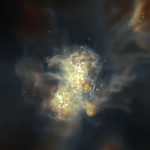 Last week we submitted our paper, The Birth of a Galaxy. II. The Role of Radiation Pressure, to the Monthly Notices of the Royal Astronomical Society. Today we posted the submitted version to astro-ph.
Last week we submitted our paper, The Birth of a Galaxy. II. The Role of Radiation Pressure, to the Monthly Notices of the Royal Astronomical Society. Today we posted the submitted version to astro-ph.
In this paper, we investigated how radiation pressure shapes the interstellar medium (ISM) and star formation in high-redshift dwarf galaxies. We compared three cosmological radiation hydrodynamics simulations that only differed in their physics set. The reference model was the work presented in Wise et al. (2012). The additional two simulations add (1) radiative cooling from metals, and (2) metal cooling, a time-dependent soft-UV background, and radiation pressure from ionizing radiation. By solving the radiative transfer equation, we can directly calculate the number of photons absorbed by each parcel of gas and thus compute the momentum transfer to the absorber. To our knowledge, this is the first cosmological galaxy formation simulation that have included these physics in this manner.
In our simulation with metal cooling, we found that our galaxies over-cooled and over-produced stars, i.e. the typical “overcooling” problem seen in many galaxy simulations. Historically this was solved by increasing resolution and including supernova feedback. Despite having both of these qualities, our simulation still was affected by this problem. This produced a unusually metal-rich (~0.3 Zsun) stellar population in a dwarf galaxy. This is not consistent with the luminosity-metallicity relationship seen in galaxies, indicative of an incorrect physical recipe in the simulation.
However we found that radiation pressure plays a key role during star formation. The momentum input from absorbed stellar radiation further drives turbulence in the ISM, providing additional support against a catastrophic collapse and decreasing star formation rates. Furthermore, a more turbulent medium can mix metals more efficiently, which further reduces the metallicity of the ISM. Both of these processes help in avoiding the overcooling problem and produce a galaxy that is consistent ([Z/H] = -2.1, L = 106 Lsun) with the luminosity-metallicity relationship. We think that our results demonstrate that radiation pressure should be considered in galaxy formation simulations in some fashion and is even a key player during the formation of the universe’s smallest galaxies.